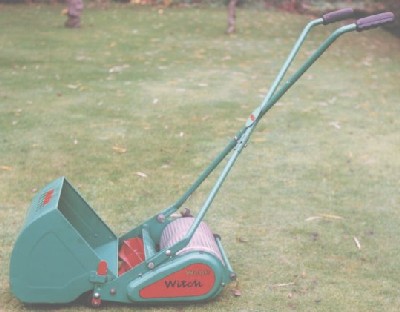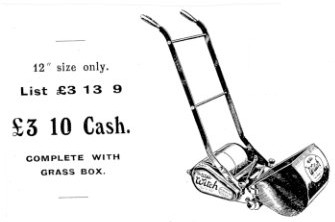MP041: Webb Witch

The Webb Witch was a popular hand mower that was manufactured from the 1930s to the 1980s.
The Witch was introduced in 1932 to complement other models in the Webb range. It was only available in 12" cutting width with a six-bladed cylinder. The Witch was initially priced at £3-13-9 (three pounds, thirteen shillings and nine pence) although the company's adverts stated it could be bought for cash at £3-10-0 including the grass box.
The design was upgraded in 1936 by introducing an eight-bladed cylinder. Using the same gearing as the earlier design this improved Witch produced 61 cuts per foot of forward motion, for a finer cut and better quality finish. This shows how the quality of cut is related to the gearing of the cutting cylinder (which affects the speed of rotation) and the number of blades on the cylinder (which is directly related to the number of cuts made during each revolution of the cylinder).
Like all Webb mowers, the Witch was a low cost machine. H C Webb was founded in the 1850s but did not produce lawn mowers until the late 1920s. Like many mower manufacturers of this period the company was better known for other products, in Webb's case it was for producing front forks for motor cycles. There are many similarities between motor cycles and lawn mowers in terms of the materials used and the machinery required to build them and many companies were involved in both industries. Royal Enfield and Charles H Pugh are two of the better known.
When it was introduced the Witch was among the first hand mowers to be manufactured from steel. Before this time the majority of mowers were made from the more bulky and heavy cast iron. As materials developed, the use of plate steel and a variety of alloys gradually replaced iron for many components. One of the benefits of this was simplified design and manufacture that led to mass production and consequently lower prices.
Early Witch models had a smooth rear roller but by the time production ceased the roller was ribbed to help the mower grip as it moved across the lawn. The first Witch mowers had conventional parallel handles but later models featured cross over handles.
Many Webb mowers have names starting with W, presumably as a marketing technique to reinforce the alliteration of the two words. Other models produced by the company include the Whippet, Wasp, Windsor, Witton and Wizard.
Webb eventually became part of the Atco-Qualcast Group and, although mowers bearing the famous old name continued in production well into the 1980s, the name is now no longer used.
Models such as the Witch are not among the rarest but they are nevertheless interesting to collectors who appreciate the design and engineering that went into them.

